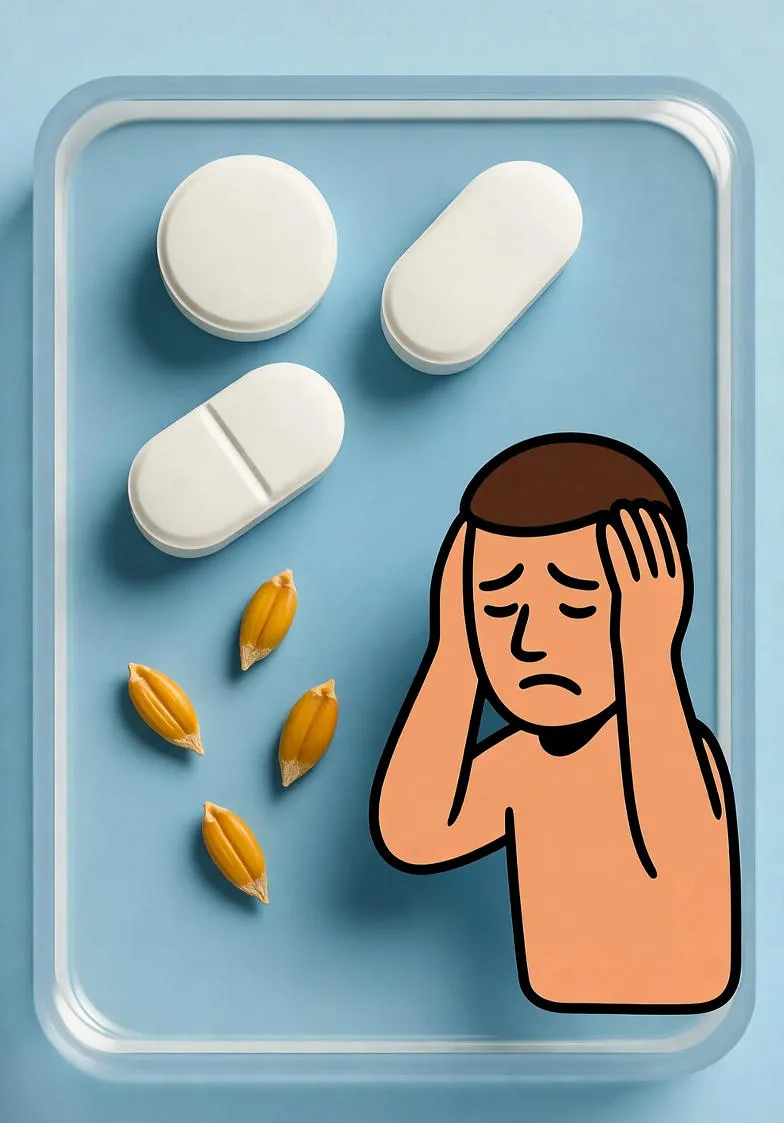Unveiling the Hidden Dangers: Gluten in Medications and the Risks for Celiac Patients
Explore the hidden risks of gluten in medications for celiac disease patients. Learn identification tips, regulatory insights, and strategies to ensure safe, gluten-free pharmaceutical choices.

Introduction
Imagine reaching for a daily medication to manage a chronic condition, only to unknowingly introduce a silent saboteur into your body—one that triggers inflammation, digestive turmoil, and long-term health complications. For the estimated 1% of the global population living with celiac disease, this scenario is not hypothetical but a very real concern. Celiac disease, an autoimmune disorder triggered by gluten, demands strict adherence to a gluten-free lifestyle. Yet, while most people focus on food labels, the presence of gluten in medications often flies under the radar, posing hidden risks that can undermine years of diligent dietary management.
This article delves into the insidious ways gluten can infiltrate pharmaceutical products, the profound health implications for those with celiac disease or non-celiac gluten sensitivity, and practical strategies to safeguard your well-being. By understanding these concealed threats, you empower yourself to make informed choices about the pills you pop every day.
Understanding Gluten and Its Impact on Health
Gluten is a family of proteins found in wheat, barley, rye, and sometimes oats due to cross-contamination. In everyday foods like bread, pasta, and beer, it's a staple ingredient. For individuals with celiac disease, however, gluten acts as a toxin. Upon ingestion, it prompts the immune system to attack the small intestine's lining, leading to villous atrophy. This damage impairs nutrient absorption, resulting in a cascade of symptoms: abdominal pain, bloating, diarrhea, fatigue, and weight loss.
Beyond the immediate gastrointestinal distress, chronic exposure exacerbates risks for secondary conditions. Osteoporosis arises from calcium and vitamin D malabsorption, while anemia stems from iron deficiencies. Neurological issues like peripheral neuropathy, skin rashes such as dermatitis herpetiformis, and even increased cancer risks, including non-Hodgkin lymphoma, have been linked to untreated celiac disease. For those with non-celiac gluten sensitivity, symptoms may mimic celiac but without intestinal damage—yet the discomfort is no less debilitating.
The cornerstone of management is a lifelong gluten-free diet. But here's where complications arise: gluten isn't confined to the kitchen. It lurks in unexpected places, including the very medications prescribed to treat these very symptoms or unrelated ailments.
How Gluten Infiltrates Medications
Pharmaceuticals, particularly oral tablets and capsules, rely on a complex array of ingredients. Active ingredients deliver the therapeutic effect, but inactive ingredients—or excipients—serve crucial roles: binding the pill together, providing bulk, masking bitter tastes, or ensuring proper dissolution in the body. It's in these excipients that gluten can hide.
Common culprits include starches derived from gluten-containing grains. Wheat starch, for instance, is occasionally used as a binder or disintegrant. Modified starches, pregelatinized starches, dextrates, dextrin, and dextrimaltose (especially if barley malt-derived) are red flags unless their sources are explicitly gluten-free, such as corn or potato. Caramel coloring from barley malt syrup is another potential source. Even seemingly innocuous ingredients like maltodextrin can raise concerns if processed from wheat, though highly refined forms typically contain negligible gluten.
Unlike food products, medications aren't required to list allergen details prominently. The FDA regulates drug labeling, but gluten disclosure isn't mandatory. This opacity stems from the fact that excipients are considered inert and safe for the general population. For celiacs, however, even trace amounts—potentially as low as 0.5 milligrams per dose—can provoke reactions, far below the 20 parts per million (ppm) threshold for gluten-free food labeling.
Generic versions of the same drug can differ dramatically in excipients, as manufacturers source ingredients variably. A switch from brand-name to generic might inadvertently introduce gluten. Moreover, manufacturing processes could involve shared equipment with gluten-containing products, though cross-contamination risks are low due to stringent FDA air quality controls.
The Hidden Risks: More Than Just Stomach Upset
The dangers of gluten in medications extend far beyond transient discomfort. For celiac patients, inadvertent exposure can reignite intestinal inflammation, reversing healing progress and perpetuating malabsorption. A single contaminated pill might trigger days of symptoms, eroding trust in medical treatments and leading to non-compliance.
Symptoms often overlap with common medication side effects—nausea, headaches, or fatigue—making diagnosis tricky. A patient on antibiotics for an infection might attribute bloating to the drug itself, not realizing gluten is the true offender. This diagnostic delay can prolong suffering and complicate care.
Long-term, repeated exposures compound risks. Nutrient deficiencies worsen, heightening susceptibility to osteoporosis, infertility, and thyroid disorders. Research from Beyond Celiac highlights that no safe gluten threshold exists for medications; even minuscule amounts can elicit immune responses. A 2011-2014 FDA-funded study surveyed over 5,600 individuals, with 1,399 reporting adverse reactions suspected from gluten-laden meds. Testing 39 common drugs revealed variability: some below detectable limits, others exceeding safe thresholds when dosed cumulatively.
Particularly vulnerable are those with refractory celiac disease, where the intestine doesn't heal despite a gluten-free diet. For them, any gluten is catastrophic. Even for others, the psychological toll—constant vigilance and anxiety—can't be understated. It's a reminder that health management requires holistic scrutiny, not just dietary tweaks.
Prevalence: Rare But Real
Thankfully, gluten in U.S. medications is uncommon. The FDA asserts that most oral drugs contain no gluten or virtually none. No products intentionally add wheat gluten or flour as excipients, and barley or rye derivatives are exceedingly rare. A database scan of over 8,000 products found only 11 using wheat starch explicitly.
Yet, rarity doesn't equate to irrelevance. Examples include certain formulations of prednisone, where a switch to a gluten-containing version caused severe celiac flares in case studies. Over-the-counter pain relievers, antacids, and allergy meds have been flagged in patient reports. Vitamins and supplements pose additional hurdles; while dietary supplements fall under food labeling rules (requiring <20 ppm for 'gluten-free' claims), many lack enrichment for celiacs' common deficiencies like B vitamins or iron.
The 2017 FDA draft guidance underscores this: while exposures are minimal, transparency is key. It recommends manufacturers label products as 'Contains no ingredient made from a gluten-containing grain' when applicable, placed in the 'Description' or 'Inactive Ingredients' sections.
Navigating the Regulatory Maze
Regulation lags behind need. Unlike the EU's stricter allergen disclosures, U.S. drug labeling doesn't mandate gluten warnings. The FDA's 2017 draft guidance, open for comments until 2018, drew over 800 responses, many from advocacy groups like Beyond Celiac. Bills like the 2019 Gluten in Medicine Disclosure Act (H.R. 2074 and S.3021) aimed to enforce labeling but stalled in committees.
Advocacy continues through initiatives like the GREAT Pharmacists program, training dispensers on celiac concerns. Resources such as DailyMed and MedlinePlus allow ingredient searches, but verification remains manual. This gap fuels calls for validated testing methods tailored to meds—current food assays aren't suitable, as they miss hydrolyzed gluten fragments.
Empowering Yourself: Strategies to Avoid Gluten in Meds
Knowledge is your best defense. Start with label scrutiny: peruse 'Inactive Ingredients' for unspecified starches or wheat derivatives. If ambiguous, don't hesitate—contact the manufacturer. Inquire about:
- Sources of starches and binders (corn? Potato?)
- Production processes and cross-contamination prevention
- Gluten testing protocols
- Changes in formulations
Pharmacists are invaluable allies. Explain your celiac diagnosis, emphasize trace gluten risks, and request gluten-free alternatives or compounded versions. Compounding pharmacies can recreate meds with certified gluten-free excipients, ideal for sensitivities.
For vitamins, opt for those labeled gluten-free and enriched for deficiencies. Resources abound: Beyond Celiac's Gluten in Medications Guide, Dr. Plogsted's Gluten-Free Drugs list (though dated), and The Rubins' manufacturer directory. If reactions occur, consult your doctor immediately—don't self-discontinue prescriptions. Rule out other causes, then report to the manufacturer for investigation.
Pro tip: Maintain a medication diary, noting brands, generics, and symptoms. This aids pattern recognition and informs future choices.
Vitamins, Supplements, and Beyond
Celiacs often face nutritional gaps, making supplements tempting. Yet, gluten hides here too, in binders or coatings. Prioritize third-party certified gluten-free options. Common needs include iron for anemia, calcium/vitamin D for bones, and B vitamins for energy. Consult a dietitian to tailor regimens, as absorption improves post-diet adherence.
Herbal supplements and probiotics warrant similar checks—some use malt-based fillers. Always verify, as 'natural' doesn't guarantee safety.
Conclusion: Vigilance as the Key to Thriving
Gluten in medications represents a subtle but significant threat to celiac health, capable of derailing progress and amplifying vulnerabilities. While prevalence is low, the stakes are high—demanding proactive measures from patients, providers, and regulators alike. By decoding labels, leveraging professional support, and staying abreast of advocacy updates, you reclaim control over your treatment.
Remember, a gluten-free life isn't just about what you eat; it's about what you ingest in every form. Armed with this insight, step forward confidently, ensuring every dose supports—not sabotages—your vitality. Your body deserves nothing less.


